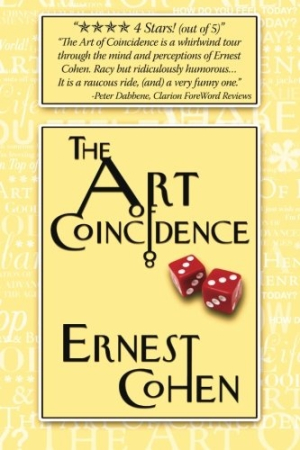
The Art of Coincidence
After all the test-marketing and focus-grouping used by publishers, it’s rare that any book truly surprises the avid reader. Individual short stories are perhaps better able than most types of writing to break free from the bonds of expectation because they can take additional chances. With The Art of Coincidence, Ernest Cohen has written a strange, funny, and unpredictable collection of stories.
In his first foray into this genre, Cohen’s style might best be described as tangential because his tales are often interrupted for several pages of story-within-story. While several stories are set in California, there is not much connecting any of them thematically, other than Cohen’s freewheeling style. Cohen makes some use of footnotes in the style of David Foster Wallace and occasional graphics, such as a mock newspaper, to vividly illustrate a character feeling that the world is against him. While these diversions are not always successful, more often than not they bring an additional vibrancy to the text.
This is not a book for the easily offended—targets of Cohen’s humor include religion, politicians, and various ethnicities, which at times drift toward stereotypes. But in some ways, that’s the point. For example, “How Do You Feel Today?” features a racy but ridiculously humorous conversation between three Muslim suicide bombers and their prospective Jewish accountant. The author engages in vivid descriptions, such as “he fell backwards with more plop than a shill at a Pentecostal revival,” and “two long lines of cocaine, which were sucked up faster than Christians at the Rapture.” While the content might test the bounds of propriety, its primary purpose is always to entertain, and no single target is exclusively discriminated against. Cohen seems to be a classic equal-opportunity offender.
The Art of Coincidence is an unusually handsome book, with many different font styles used throughout. The variety helps readers differentiate between stories and speakers, but it also simply makes the text look more interesting than a typical story collection.
Strangely, given Cohen’s obvious ability to turn a well-written humorous phrase, the book’s biggest flaw is the presence of multiple editing errors. While the author’s meaning can still be discerned, it is distracting to see “mote” instead of “moat,” “peak” instead of “peek,” and “shinning” instead of “shining,” among other examples. The tangents upon tangents of these stories may not be for every reader, and at times the writing can be uneven, seeming more like a series of vignettes or skits than stories. But perhaps such is the price of keeping readers guessing.
The Art of Coincidence is a whirlwind tour through the mind and perceptions of Ernest Cohen. While it is a raucous ride, it’s also a very funny one.
Reviewed by
Peter Dabbene
Disclosure: This article is not an endorsement, but a review. The publisher of this book provided free copies of the book and paid a small fee to have their book reviewed by a professional reviewer. Foreword Reviews and Clarion Reviews make no guarantee that the publisher will receive a positive review. Foreword Magazine, Inc. is disclosing this in accordance with the Federal Trade Commission’s 16 CFR, Part 255.
